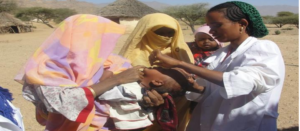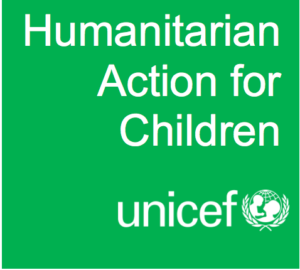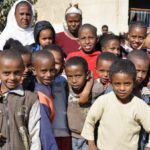In Eritrea, where the vast majority of livelihoods depend on subsistence agriculture and pastoralism, 80 per cent of the population is vulnerable to recurrent drought. Since 2015, Eritrea has experienced drought conditions caused by El Niño that further undermined household food and livelihood security, particularly for women and children, and contributed to a cholera outbreak across three of the country’s six regions. These dynamics have led to high levels of malnutrition among children under 5, pregnant women and lactating mothers, particularly in the lowland areas. According to the Nutrition Sentinel Site Surveillance System, malnutrition rates have increased over the past three years in four out of the country’s six regions, where malnutrition rates already exceeded emergency levels, with 22,700 children under 5 projected to suffer from severe acute malnutrition (SAM) in 2017.
Nutrition and water, sanitation and hygiene (WASH) practices are sub-optimal, with less than half of the rural population accessing safe drinking water and only 11.3 per cent of the overall population accessing improved sanitation. Half of all children in Eritrea are stunted,and as a result, these children are even more vulnerable to malnutrition and disease outbreaks.
 Humanitarian strategy UNICEF and partners will continue to mainstream humanitarian response within
Humanitarian strategy UNICEF and partners will continue to mainstream humanitarian response within
regular development programmes targeting the most vulnerable children and will apply an integrated multi-sectoral approach to lifesaving interventions in Eritrea, building on linkages between the humanitarian and development programmes. In 2017, UNICEF will support the Government to implement blanket supplementary feeding to prevent the further deterioration of the nutritional status of children under 5, pregnant women and lactating mothers. This will include procuring routine medicines for the management of SAM and moderate acute malnutrition (MAM). UNICEF will apply a multi-sectoral approach in drought-prone rural communities facing heightened risk of diarrhoea and cholera and high levels of food insecurity and malnutrition. Local capacities will be built in these communities through outreach and training programmes to support the provision of safe water and access to appropriate hygiene practices. UNICEF will strengthen health systems to support service delivery and will prioritize routine immunization coverage and community case management of childhood illnesses. Schools in the most-affected areas will offer programmes designed to raise children’s awareness of explosive remnants of war. UNICEF will also support the enrolment of 15,000 (currently out-of-school) nomadic children from drought-prone areas, working with the Ministry of Education, via advocacy campaigns, outreach and enrolment programmes to support children’s return to school. Communication for Development will be used to achieve programme results in all sectors.
Results from 2016
 As of 31 October 2016, UNICEF had received US$7.8 million against the US$16 million appeal (49 per cent funded). Some 13,000 children under 5 with SAM and 34,000 children under 5 with MAM were treated and 376,000 children received vitamin A. In addition, 30,000 pregnant women and lactating mothers and children under 5 living in hard-to-reach areas benefited from blanket supplementary feeding (less than planned due to limited funding). Approximately 97,000 children were immunized against measles and 70,000 children affected by acute watery diarrhoea received life-saving curative interventions. UNICEF surpassed its targets for vitamin A and acute watery diarrhoea support by reprogramming regular programme funds and liaising with the Ministry of Health and the World Health Organization (WHO). A total of 31,000 people benefited from improved access to safe water, including 10,500 people in seven communities with new solar-powered water supply schemes, and 20,500 people in cholera-affected regions through the provision of water treatment supplies for one month. Key preventative messages on protection, education, health and nutrition reached more than 1 million people in highrisk areas. While 5,000 children were reached with psychosocial support, fewer children than planned accessed mine risk education and basic education due to limited funding for child protection and education activities.
As of 31 October 2016, UNICEF had received US$7.8 million against the US$16 million appeal (49 per cent funded). Some 13,000 children under 5 with SAM and 34,000 children under 5 with MAM were treated and 376,000 children received vitamin A. In addition, 30,000 pregnant women and lactating mothers and children under 5 living in hard-to-reach areas benefited from blanket supplementary feeding (less than planned due to limited funding). Approximately 97,000 children were immunized against measles and 70,000 children affected by acute watery diarrhoea received life-saving curative interventions. UNICEF surpassed its targets for vitamin A and acute watery diarrhoea support by reprogramming regular programme funds and liaising with the Ministry of Health and the World Health Organization (WHO). A total of 31,000 people benefited from improved access to safe water, including 10,500 people in seven communities with new solar-powered water supply schemes, and 20,500 people in cholera-affected regions through the provision of water treatment supplies for one month. Key preventative messages on protection, education, health and nutrition reached more than 1 million people in highrisk areas. While 5,000 children were reached with psychosocial support, fewer children than planned accessed mine risk education and basic education due to limited funding for child protection and education activities.


Leave A Reply